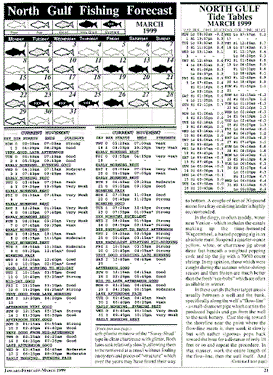
The Saltwater Magazine for Gulf Coast Fishing!
FISHING FORECASTS
| FISHING CALENDARS | ARTICLES
Search Gulf Coast
Fisherman's Web Site
Past articles,
specific places or fish, etc.

How the Forecast Works
Part II
| CURRENT
MOON lunar phases |

- (This is what a page from the Wells Daily Fishing Forecast looks like. You can actually read it in the magazine!)

- (This is what a page from the Wells Daily Fishing Forecast looks like. You can actually read it in the magazine!)
"Why" the Forecast works is known to thousands of fishermen
who depend on the Wells Daily Fishing Forecast to plan their fishing
trips. This explanation is mostly for new (to the Forecast) fishermen but
regular users can still benefit by reviewing the information from time to
time.
It is essential to understand that fish and their
food start moving IN or OUT as soon as a tidal current has gained enough
horizontal speed to force them in the direction of its flow.
The time required for a tidal current to build up to a horizontal speed of at least three tenths of a knot (forcing speed) can be from minutes to several hours. For this reason, times given in the column "Starts", can never be correlated to the time of "High Tide" or "Low Tide" as given in the magazine.
Sample days from the WELLS DAILY FISHING FORECAST CURRENT MOVEMENT
DAY DIR STARTS ENDS STRENGTH
(1) (2) (3) (4) (5)
TUE I 05:30am 09:50am Good
1 O 01:15pm 02:35pm Very Weak
O 10:20pm 04:20am* V Strong
GOOD TO MID-MORNING (6)
WED I 06:35am 09:15am Good
2 O 02:15pm 05:25pm (7) V Strong2(8)
EARLY MORN, MID AFTERNOON BEST
|
The Wells Daily Fishing Forecast starts with the time when a tidal current has reached necessary speed or "Forcing Power" to start a movement in the direction indicated, either "IN" or "OUT." The second time figure represents the end of the "Forcing Power" as the current slows down to slack water time.
Analyzing the two time figures, we start with the first column, the time
when movement starts. This time figure compared with the last time on the
previous line tells you the length of time since the current moved the fish.
If the previous current moved IN, then the fish will still be IN until after
starting time on this line. If they were moved OUT on the previous current,
then they won't start IN until after this first time figure.
This starting figure represents the time when a tidal current has gained
speed and force to start movement in the direction indicated. This time
figure represents the beginning of a period when you do not have to hunt
for your fish. By just being stationed on a known and proven reef or channel
leading to or from shallow water, the tidal current will bring the fish
to you. These periods of movement will generally provide the best and fastest
action of the day because the schools of fish will be concentrated and will
always be feeding on their moving and exposed food.
Because the best fishing usually occurs each day immediately following
the time shown in the starting column, the variations involved are
worth studying. First, a study of flooding or incoming currents, in the
table below, shows that the IN movement of fish will be faster and less
gradual than the OUT movement on the next ebbing current. While the next
outgoing is current is weak, it is only in advance of a much stronger outgoing
current later in the evening, with no intermediate incoming current in between.
The next strong incoming current does not begin until the next morning.
Fishing will be slow in the early afternoon with fairly long intervals between
schools of fish feeding their way into the shallow water areas. However,
the continuing action should hold you at your fishing spot until this movement
has ended. On the other hand, when the strong current begins to ebb or go
OUT, it will move everything in a short period of time. Except when a tide
is rated Weak or Very Weak, the gamefish will be out of shallow water well
before the time shown when movement is predicted to end.
The column of Current Speed Ratings designates each current by its strongest
speed. Each of these ratings represents a definite speed range. These speed
ranges are Very Weak; Weak; Moderate; Good-Strong; Very Strong; and , Extra
Strong. A current rated Good, for instance, will always have the same strength
and speed range regardless of when it occurs, either ebbing or flooding.
It is very important to adjust the times as shown in the Fishing Forecasts to the area where you are fishing. The times given are for approximately the center of the various bays. (At this time, we have not published the adjustment times for the Forecast page shown). Areas nearer the Gulf passes have movements starting earlier so subtract time from that shown. Fishing areas further into the Bays will have movements starting later than the times given.
Consulting the adjustment times listed in the magazine for your area, or approximate area, will put you in the ballpark for any spot you are fishing.
Home | Back to Part I | Back to Fishing Calendars | Go to Fishing Forecast
